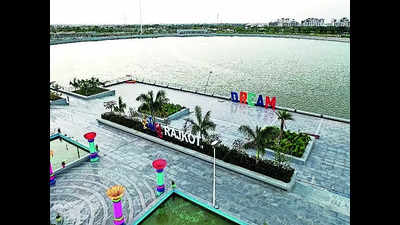- News
- City News
- rajkot News
- Rajkot city to celebrate its 414th foundation day today
Trending
Rajkot city to celebrate its 414th foundation day today

The city, which has emerged as India’s pivot for engineering and automobile goods over the centuries, was founded by Thakor Vibhaji Jadeja and his loyalist Raju Sandhi on the banks of the Aji River in 1610 AD.Initially, the city was limited to Kothariya Naka, Raiya Naka, Bedi Naka, and Bhichri Naka, which are now part of the old city.
Rajkot's history is rich and diverse. It came under Mughal rule in 1776 when Junagadh’s Masum Khan took possession of the Saradhar area and renamed the city Masumabad. However, it reverted to Rajkot during British rule. Over the years, the city has been governed by various rulers, each contributing to its architectural and educational landscape, including the Dharmendrasinhji Law College, Rajkumar College, Dharmendrasinhji Cloth Market, Bavajiraj School, Lakhajiraj Library, and Ranjit Vilas Palace. A significant chapter in Rajkot's history is its connection with Mahatma Gandhi. Gandhiji’s father, Karamchand Gandhi, served as a diwan (secretary) to Rajkot’s ruler, Bavajiraj. Gandhiji himself studied in Rajkot, and today, tourists flock to Kaba Gandhi no Delo, where he lived, and Alfred High School, now a museum dedicated to his life. Other notable sites include the Rashtriya Shala and Kasturba Ashram.
The influence of Buddhism in Rajkot is evident through the ancient Baudh caves at Tramba and Khambalida, which stand as a testament to the city’s historical spiritual diversity.
In modern history, Rajkot played a central role when Gujarat was part of Mumbai state until 1960, serving as the capital of Saurashtra. Despite being the fourth-largest city in Gujarat, Rajkotians often consider their culture and food habits distinct from the rest of the state, showcasing a unique identity within the broader Gujarati context.
The city saw industrial growth with the establishment of its first ginning mill in Karanpara in 1938 and the first industrial area in Bhaktinagar in 1952. Today, Rajkot is renowned as a hub of MSMEs in India, known for its engineering, auto parts, machine tools, submersible pumps, and diesel engines. Additionally, it is a significant center for imitation jewelry, widely used in the Bollywood industry, alongside a thriving bullion market.
We also published the following articles recently
Fake school operating from shops busted near Rajkot
Discover the shocking discovery of a fake English medium school in Rajkot, operating without affiliation and using former students as teachers. Learn how the education department is taking action under the Right to Education Act.
Discover the shocking discovery of a fake English medium school in Rajkot, operating without affiliation and using former students as teachers. Learn how the education department is taking action under the Right to Education Act.
Rahul Gandhi to visit Gujarat on July 6; to meet Rajkot fire victims' kin
Learn about Rahul Gandhi's visit to Ahmedabad to address party workers and meet families affected by recent tragedies in Gujarat. The visit comes after a clash between BJP and Congress workers over remarks made by Gandhi. Get all the details here.
Learn about Rahul Gandhi's visit to Ahmedabad to address party workers and meet families affected by recent tragedies in Gujarat. The visit comes after a clash between BJP and Congress workers over remarks made by Gandhi. Get all the details here.
How rain exposed fragile infra at Rajkot International Airport
Read about the recent canopy collapse at Rajkot International Airport caused by water accumulation and gusty winds. Learn how the incident, which did not result in any injuries, has not affected flight operations. Discover more about the airport's construction and its current operations connecting various destinations.
Read about the recent canopy collapse at Rajkot International Airport caused by water accumulation and gusty winds. Learn how the incident, which did not result in any injuries, has not affected flight operations. Discover more about the airport's construction and its current operations connecting various destinations.
End of Article
FOLLOW US ON SOCIAL MEDIA










